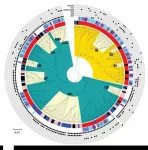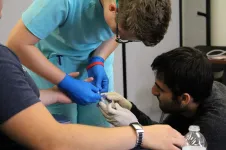New COVID-19 model reveals effectiveness of travel restrictions
Model examines global proximity in relation to disease spread
2021-06-07
(Press-News.org) TROY, N.Y. -- More strategic and coordinated travel restrictions likely could have reduced the spread of COVID-19 in the early stages of the pandemic. That's according to new research published in Communications Physics. This finding stems from new modeling conducted by a multidisciplinary team of scientists and engineers at Rensselaer Polytechnic Institute.
The researchers evaluated the distance between countries in terms of air travel, a more complex measurement than simply mapping physical distance. For instance, while China and Thailand may be geographically more proximate to one another, if there are significantly more flights between China and the United States, the chance of disease spread may be higher.
"This is considered a global problem," said Mamadou Diagne, an assistant professor of mechanical, aerospace, and nuclear engineering at Rensselaer, "so we wanted to know if coordinated action could be taken to mitigate contamination rates all across the world."
By mapping and analyzing the global mobility network through air traffic patterns, the researchers were able to determine the level of connection between various nations and develop a model that can predict which countries are closer to one another in terms of disease spread. The model was able to successfully predict when the virus arrived in the United States.
Using this approach, the team examined the effectiveness of various travel restrictions countries implemented in an effort to slow the transmission of the virus that causes COVID-19.
"For example, we found that the Chinese lockdown reduced the arrival time of the virus in uninfected countries by about 10 days," said Jianxi Gao, an assistant professor of computer science at Rensselaer. "And, it reduced the number of infections by 6 million globally."
Travel restrictions enacted by other nations, including entry bans, global travel bans, and lockdowns, also helped to reduce the global spread. However, the Rensselaer team found that these actions could have been significantly more effective had countries worked in concert with one another.
"According to the data we collected, about 63.2% percent of travel restrictions were ineffective," said Lu Zhong, a postdoctoral researcher in mechanical, aerospace, and nuclear engineering. "Because the travel restrictions were done in an uncoordinated way, they failed to contribute to the global good."
Diagne, Gao, and Zhong found that redundant or unnecessary travel restrictions also affected the global economy. A more efficient approach, they said, could mitigate economic harm.
INFORMATION:
Researchers started this work before the COVID-19 pandemic began, though they were focused on a different disease at that time. They believe the model could be applied to future pandemics in addition to alleviating some of the ongoing effects of the current one.
These findings were initially published in preprint on MedRxiv, an online repository of papers that have been screened but not peer-reviewed.
About Rensselaer Polytechnic Institute
Founded in 1824, Rensselaer Polytechnic Institute is America's first technological research university. Rensselaer encompasses five schools, 32 research centers, more than 145 academic programs, and a dynamic community made up of more than 7,600 students and over 100,000 living alumni. Rensselaer faculty and alumni include more than 145 National Academy members, six members of the National Inventors Hall of Fame, six National Medal of Technology winners, five National Medal of Science winners, and a Nobel Prize winner in Physics. With nearly 200 years of experience advancing scientific and technological knowledge, Rensselaer remains focused on addressing global challenges with a spirit of ingenuity and collaboration. To learn more, please visit http://www.rpi.edu.
ELSE PRESS RELEASES FROM THIS DATE:
2021-06-07
In young women, Staphylococcus saprophyticus is a main cause of urinary tract infections (UTI), reaching 20% prevalence. Understanding the epidemiology of this microorganism can help identify its origin, distribution, causes, and risk factors. Now, ITQB NOVA researchers led by Maria Miragaia showed evidence that Staphylococcus saprophyticus can originate in food, namely in the meat-production chain.
Europe is the world's second-biggest producer of pork, the most favored meat type in these countries. One of the contaminants of that meat is S. saprophyticus, which is found also in the environment, ...
2021-06-07
BOSTON - Current guidelines recommend stopping cervical cancer screening at age 65, but women over age 65 make up over one in five new cervical cancer diagnoses, and are twice as likely to die after a cervical cancer diagnosis compared to younger women. New research from Boston Medical Center found that fewer than one in three women aged 64 to 66 met the criteria to discontinue cervical cancer screening while looking at patients with both private insurance and from a safety-net hospital setting. Published in Gynecologic Oncology, researchers found that even among women with 10 years of continuous insurance coverage, ...
2021-06-07
GAINESVILLE, Fla. --- A more reliable way of estimating the size of megalodon shows the extinct shark may have been bigger than previously thought, measuring up to 65 feet, nearly the length of two school buses. Earlier studies had ball-parked the massive predator at about 50 to 60 feet long.
The revised estimate is the result of new equations based on the width of megalodon's teeth - and began with a high school lesson that went awry.
Victor Perez, then a doctoral student at the Florida Museum of Natural History, was guiding students through a math ...
2021-06-07
PHILADELPHIA (June 7, 2021) - An article written almost 30 years ago helps frame social constructs around the COVID-19 pandemic. By reviewing the essay, an historian of nursing at the University of Pennsylvania School of Nursing (Penn Nursing) extends that construct to include nurses and patients, delivering a local and personal meaning to the epidemic experience.
In an essay in the Bulletin of the History of Medicine, Julie A. Fairman, PhD, RN, FAAN, Endowed Chair, the Nightingale Professor in Honor of Nursing Veterans, and Professor of Nursing at Penn Nursing, reviews Charles Rosenberg's 1992 article about the AIDS epidemic. Using Rosenberg's theme, she further develops the ...
2021-06-07
Metal halide perovskites have been under intense investigation over the last decade due to the remarkable rise in their performance in optoelectronic devices such as solar cells or light-emitting diodes. Despite tremendous progress in this field, many fundamental aspects of the photophysics of perovskite materials remain unknown, such as a detailed understanding of their defect physics and charge recombination mechanisms. These are typically studied by measuring the photoluminescence - i.e. the emission of light upon photoexcitation - of the material in both the steady-state and transient regimes. ...
2021-06-07
Rockville, Md. (June 7, 2021) - Healthy habits are particularly important during pregnancy. Four new studies being presented at NUTRITION 2021 LIVE ONLINE look at how supplements, eating habits and physical activity can affect various aspects of health during pregnancy.
Prenatal supplements might influence bacterial composition of breast milk
Breast milk contains a unique mix of bacteria - known as its microbiota - that plays an important role in child health. In a new study, researchers from Purdue University examined whether diet or supplements taken prenatally affected the microbiota of breast milk in 771 mothers participating in the CHILD Cohort Study. The analysis revealed that supplements, but not dietary patterns, were linked with changes in human milk microbiota ...
2021-06-07
Rockville, Maryland (June 7, 2021) -- Only 5% of men and 9% of women are getting the recommended daily amount of dietary fiber, according to a study being presented at NUTRITION 2021 LIVE ONLINE. Insufficient fiber intake is associated with a higher risk of heart disease and diabetes, two of the most common diseases in the U.S.
"These findings should remind people to choose fiber-rich foods like whole grains, fruits and vegetables to reduce their risk for heart disease," said Derek Miketinas, PhD, RD, an assistant professor at Texas Woman's University, the study's ...
2021-06-07
Rockville, Maryland (June 7, 2021) -- Reducing food waste is crucial to our ability to feed the growing human population but will not fully solve the problem alone, according to a new study based on a computational model.
Researchers calculate that the world already produces enough protein and energy to feed 9.7 billion people--the projected population as of 2050--if food waste were cut in half. However, projections indicate global food production will still fall short in terms of micronutrients that our bodies need to stay healthy, including calcium, iron, vitamin E and others.
"Reducing food waste would give us enough protein and food energy to feed the 2050 population today--but not enough of the essential ...
2021-06-07
Rockville, Maryland (June 7, 2021) -- According to a new study, people who eat faster or take larger bites are more likely to eat more at a meal. The research, which is being presented at NUTRITION 2021 LIVE ONLINE, provides new insight into the factors that might contribute to overeating.
The study also adds more evidence that people eat more when given larger portions. The researchers found that study participants ate, on average, 43% more when the portion size of a meal was increased by 75%.
"Although studies have consistently found that people eat more when they are served larger portions, less is known about why this happens or why some people ...
2021-06-07
Rockville, Md. (June 7, 2021) - Superfoods like turmeric and honey have long been recognized for their ability to promote health and wellness. New studies being presented at END ...
LAST 30 PRESS RELEASES:
[Press-News.org] New COVID-19 model reveals effectiveness of travel restrictions
Model examines global proximity in relation to disease spread








